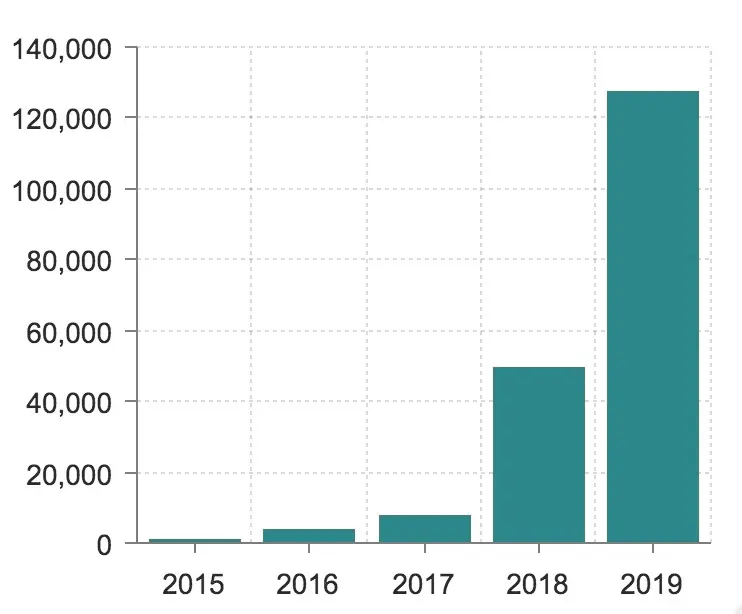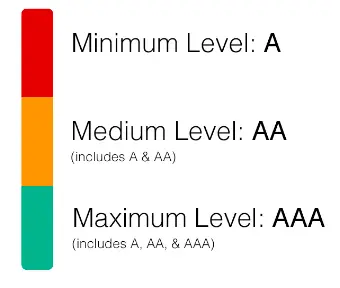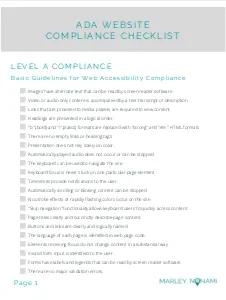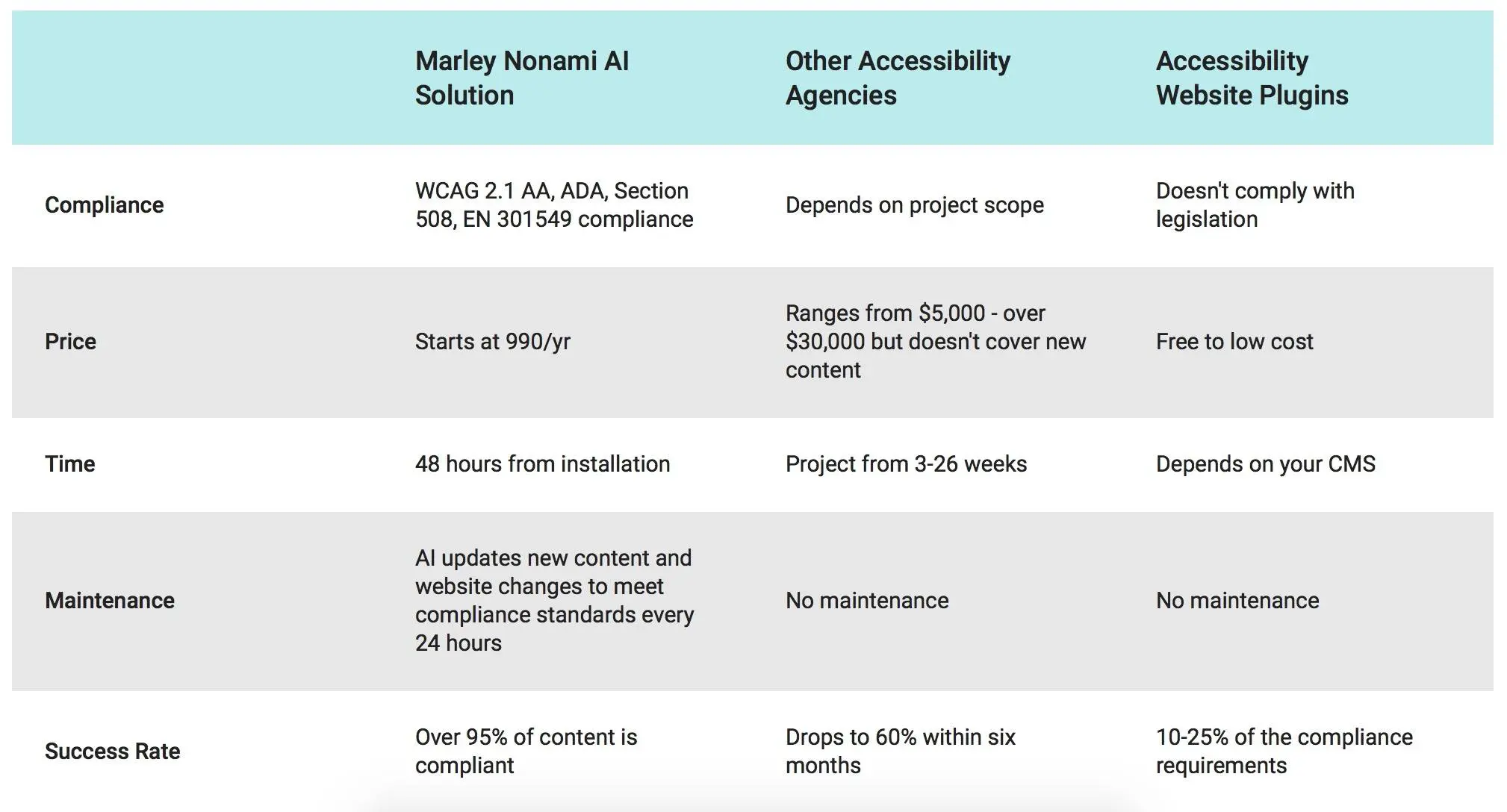FREE Instant ADA Website Compliance Checker
What is ADA Website Compliance Checker?
This easy to use website compliance checker will ask you 5 simple questions to determine your risk with ADA Website Compliance. This is just a preliminary assessment to determine if your business fails into a Low-Medium or High Risk category.
Do you want an ADA Website Compliance Checklist?
If you would prefer to download an ADA Website Compliance Checklist and skip the Free ADA Website Compliance Risk Assessment, no sweat. Click here to see the ADA Compliance Website Checklist. From there you can print or save the free PDF Checklist. No email required. Click the link above or the image to the left.
38+ Million People are Effected by Poor Web Accessibility in the US!
19.9M Can't Use a Mouse - 8.1M Visually Impaired - 2M Blind - 7.6M Auditory Impaired - 2.2M Suffer from Seizures/Epilepsy
Avoid the Cost and Pain of ADA Website Accessibility Lawsuits
- 200% increase in lawsuits and demand letters from 2018 to 2019
- DOJ confirms ADA applies to websites
- Over 150,000 demand letters served since 2017
- 93% of demand letters settle outside court for $20,000 - $150,000
- 7% of business fight and lose in court

*Number of lawsuits and demand letters estimated from several sources.
Not sure you need to worry about ADA Website Compliance? Learn more
What is Web Accessibility?
Web accessibility is a set of rules, behaviors, code standards and design guidelines that are meant to allow people with disabilities, which comprise 20% of the world’s population, to effectively use websites.
To achieve this, the W3C (The World Wide Web Consortium) has created the “Web Content Accessibility Guidelines” 2.1 (WCAG 2.1), which are meant to explain and guide developers on how to make websites accessible. These guidelines have been adopted by governments around the world and are now a part of various legislations, such as the ADA, Section 508, EN 301549, and others.
The WCAG focuses mainly on three areas of accessibility: blind people using screen-readers (JAWS, NVDA), people with motor impairments that are using the keyboard, and a variety of other disabilities such as color blindness, epilepsy, and minor visual impairments that are mainly focus on the UI and design of the website (color contrasts, animations, fonts, etc.)
Is Web Accessibility Required by Law?
Yes. In 2018, the Department of Justice confirmed 4 Amendments to extend the laws of Americans with Disabilities Act (ADA) from the physical world (wheelchair ramps, handicap spaces, entryways to accommodate special needs, etc) to the digital and Web world. If you didn't know about this, don't worry, you're not alone!
In addition to the ADA Compliance Standards, there are also: The Rehabilitation Act, Department of Education (DOE), Office of Civil Rights (OCR), Air Carrier Access Act (ACAA), and the 21st Century Communications and Video Accessibility Act (CCVA). At a state level, Arizona, California, and New York have state level accessibility legislation. The highest number of lawsuits are against businesses that operate in Florida, California, and New York.
Even though 2 of those 4 ADA Amendments were withdrawn, the increase of lawsuits and settlements have still skyrocketed. 93% of demand letters settle outside court for $20,000 - $150,000. There are laws in other countries outside of the US as well, in Canada, Europe, Australia and many more.
are there different levels of ADA Web compliance?
There are three levels of ADA Web Compliance - Level A, Level AA, and Level AAA

To reduce your risk, your business should strive for at least Level AA Web Compliance.

Do I Need to Rebuild My Website to Achieve ADA Website Compliance?
NO! Do not pay someone too much money to rebuild your website when you don't have to. Rebuilding a website doesn't automatically make the new website ADA Compliant.
Instead, purchase software that will get your site 90% there. By acheiving Level AA Website Compliance, that shows that your business had made a good faith effort in trying to comply withe ADA Web Compliance regulations.
If your website frequently publishes documents like Word or PDFs, then your business should create a process that ensures that any new published documents have the Accessibility Setting turned on BEFORE putting the document on your websites. If you have PDFs that are widely used on your website, you may want to consider republishing an Accessibility friendly version of that PDF. This process can be time consuming if you have tons of PDFs. Only update the most used PDFs.
Another option is to add text to the webpages that hold the PDFs and add an Accessibility Statement that says if someone requires help to read or hear this PDF, please call or email ...
How We Help You Achieve ADA Website Compliance?
Our ADA Solution utilizes two components that, together, achieve compliance, within 48 hours.
The first is our foreground application, the accessibility interface, which is responsible for 30% of the requirements, mostly UI and design-related.
The second is our background application (Artificial Intelligent Machine Learning powered), which is responsible for the remaining 70% of requirements, mostly related to blind people’s screen-reader adjustments, and keyboard navigation optimizations for people with motor impairments.
We will start processing your website right after the initial installation and the process takes 24-48 hours. Upon completion, you’ll receive an Accessibility Statement and certification of performance directly to your email.
How You Can Be Compliant in 48 Hours?
We deliver a Superior Accessibility Solution at a Fraction of the Cost of Most ADA Providers.
Our foreground application handles the UI (user interface) accessibility requirements, allowing persons with specific disabilities to adjust the website’s UI and design to their individual needs. Our solution replaces the old-fashioned method of compromising your site’s design, in favor of accessibility.
Here are some of our interface’s capabilities:
● Font handling - users can increase and decrease font size, change its family (type), adjust spacing, alignment, line height, and more.
● Color handling - users can select various color contrast profiles such as light, dark, inverted, and monochrome. Additionally, users can swap color schemes of titles, texts, and backgrounds, with over 7 different color options.
● Animations – users with epilepsy can stop all running animations at the click of a button. This includes videos, GIFs and CSS flashing transitions.
● Content highlighting – users can emphasize important elements, such as links and titles. They can also highlight particular focused or hovered elements.
● Audio muting – users with hearing devices may experience headaches or other issues due to automatic audio playing. This option allows users to mute the entire website instantly.
● Cognitive disorders – we utilize a search engine that is linked to Wikipedia and Wiktionary, allowing people with cognitive disorders to decipher meanings of phrases, initials, slang, and more.
● Other options – users can change the cursor’s color and sizing, view in printing mode, enable a virtual keyboard, and much more.
Why Marley Nonami?
We pride ourselves on providing the best solution for the lowest price possible. Unfortunately, many attorneys and businesses are using this as an opportunity to take advantage of us and charge exorbitant amounts of money remediate websites for accessibility compliance. We have seen businesses and municipalities spend $75,000 - $150,000 to fix their websites while under the stress of a lawsuit. We want to help prevent companies from rebuilding their websites unnecessarily and wasting hard earned money or tax payer dollars with the wrong approach that doesn't serve as a long time solution.
Our AI-powered solution that is revolutionizing the industry by making web accessibility simple, automatic, immediate and affordable, in compliance with the WCAG 2.1, ADA, Section 508 and other worldwide legislation.
AI being applied for web accessibility applications is a revolutionary concept, consisting of three major advantages:
- Easy implementation and fast process - Implementation involves a 5-minute installation of a JS code that scans, analyzes and solves accessibility compliance gaps in up to 48 hours. Your website will then present a toolset for people with disabilities to apply session-based adjustments as an overlay to your website, according to their needs, and without interfering with your code base, loading times, UI or design.
- Ongoing compliance - After the initial 48 hours, the software will automatically re-scan and re-analyze your website every 24 hours to ensure that any new content, widgets, or pages are also adapted and thereby compliant with WCAG 2.1 and ADA standards.
- Price - Being fully automated and using AI allows us to dramatically cut costs of becoming compliant and ultimately makes the process of web accessibility. The cost of our automated solution starts at $4,997 for up to 50 web pages and $9,997 for up to 5,000 web pages.
What is Not Included?
Our ADA software will certify your website pages, which often accounts for 90% of your website compliance needs. However, your website may also have external document formats that are accessible to the public on your website, which will not be certified ADA compliant through the software. When files are added to websites, they are external and not a part of the website code. We can certify the website code on the website pages, which may not include external files.
This does not include the following document types:
- PDFs
- Word, Excel, or Powerpoint documents
- Videos
We can provide addition remediation suggestions or services. We recommended to determine the use and traffic to the external documents, prior to moving forward with a large remediation project. There is no point to pay to remediate documents that no one ever visits on your website.
Lastly, if your website has an element that is very unique and does not exist almost anywhere else, such as a quiz, games, ticketing section, map, builder feature or any other rare component, we may not be able to fix it automatically. AI and machine learning technologies depend on a high amount of encounters and data in order to be accurate, which means one of a kind elements will need to be viewed with human eyes and brains. In rare cases when a file may not be remediated, we have a simple workaround to improve the experience for your website visitors.
But We’re Only Human - Why Artificial Intelligence Matters?
Our Artificial Intelligence (AI) runs in the background and optimizes the accessibility level of your website every 24 hours. This AI engine remediates the website’s HTML accessibility issues, as well as functionality and behavior, to the use of blind people using screen readers, and people with motor impairments using a keyboard to operate websites.
● Screen-reader optimization: Our AI analyzes your website’s components top to bottom, thereby providing screen-readers with meaningful data, using the ARIA set of attributes. For example, it provides accurate form labels; descriptions for actionable icons (social media icons, search icons, cart icons, etc.); validation guidance for form inputs; element roles such as buttons, menus, model dialogues (popups), and more.
Additionally, our AI scans all of the website's images and provides an accurate, meaningful image-object-recognition-based description as an ALT (Alternate Text) tag. It also extracts texts that are embedded within the image, using an OCR (Optical Character Recognition) technology.
Note that we will NOT override your ALT tags, titles, or any other manual accessibility work that has been done. We take into consideration that if you’ve made adjustments yourself, it’s probably for a reason.
To turn on screen-reader or keyboard navigation adjustments at any time, click Alt+1 on your keyboard. Screen-reader users receive automatic announcements to turn on these adjustments as soon as they enter your website.
● Keyboard navigation optimization: Our AI adjusts the website’s HTML, as well as adding various behaviors using JavaScript code, to make the website fully operable by keyboard.
This includes navigating the entire site using the TAB and SHIFT+TAB keys, operating dropdowns with the arrow keys, closing them with ESC, triggering buttons and links using Enter, navigating between radio and checkbox elements using the arrow keys, filling them in with the Spacebar or Enter key, navigate using key shortcuts and more.
Additionally, keyboard users will find quick-navigation and content-skip menus available at any time by clicking Alt+1. Our AI also handles triggered popups by relocating the keyboard focus onto them as soon as they appear, without letting the focus deviate below the popup, for best orientation.
What’s Under the Hood? How Does the Technology Work?
We will scan and analyze your website using AI technologies. Then, it applies all the required adjustments to become ADA and WCAG 2.1 compliant. This process takes up to 48 hours and upon completion, you’ll get an Accessibility Statement and certification of performance directly to your email.
The process of becoming compliant using our solution is very simple:
- Install our single line of JS code.
- Your website instantly displays our accessibility interface.
- Our AI starts scanning and analyzing your website.
- In 48 hours, our AI is finished, and your website is compliant.
- Our AI re-scans for new and revised content to process every 24 hours.
The accessibility interface solves 30% of the ADA and WCAG 2.1 requirements immediately. This includes mostly UI and design features such as sizing, colors and spacing. The remaining 70% are solved within 48 hours, by our AI that runs in the background and adjusts your website, to make it operable using a screen reader (for blind people) and the Keyboard (for the motor impaired).
The AI process includes several solutions: ALT (alternate text) attribute creation for images using image recognition and OCR technologies, form label creation and handling link/button icons using a contextual understanding technology, as well as fixing popups, menus, dropdown, forms, and more.
We will not change a thing for the majority of users. It will only be activated when turned on via the interface (or by a screen-reader if the user is blind), as an overlay to your website, and only for the user’s specific session. Therefore, the software won't affect your design, UI, or performance at all. The entire process is automated. From remediation to becoming compliant. Additionally, we don’t collect user data, so we don’t have a negative affect your Privacy or GDPR compliance.
Browser, OS, and Assistive Technologies Compatibility: Google Chrome, Mozilla Firefox, Apple Safari, Opera, Microsoft Edge and I.E 11 or above, JAWS and NVDA (screen-readers), both for Windows and for MAC users.
ADA compliance isn't just the law, it's the right thing to do.

